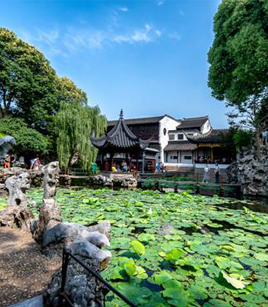Classical Chinese gardens

Lion Forest, one of the four famous gardens in Suzhou, originally built during the Yuan Dynasty Photo: VISITSZ
Classical Chinese gardens are one of the greatest achievements in Chinese traditional architectural culture. The earliest form of the gardens appeared during the Shang Dynasty (c. 1600–1046 BCE), when they served as enclosed parks where kings and nobles hunted for pleasure.
The Tang Dynasty (618–907) was considered the golden age of Chinese culture, and the art of Chinese gardens reached a zenith. Influenced by thriving landscape painting and poetry, the aesthetic quality and the idea of obtaining harmony with nature was highlighted. The capital, Chang’an, was a cosmopolitan city, filled with diplomats, merchants, pilgrims, monks and students, who carried the arts of the gardens all over Asia. The Song Dynasty (960–1279), another golden age of Chinese gardens, featured the prosperity of imperial gardens and many smaller but equally picturesque private gardens. The fall of the Northern Song regime caused a shift of political and economic influence from north to south, promoting the development of gardens in south China.
Chinese gardens have developed four archetypes in accordance with their locations. Gardens in the Jiangnan area, or south of the lower reaches of the Yangtze River, standardized many of the key features of classical Chinese garden design with constructed landscapes mimicking the natural scenery of rocks, hills, and rivers with strategically located pavilions and pagodas. The elegant aesthetics and subtlety of these gardens are often imitated by various gardens in other parts of China. The gardens native to the Lingnan area in south China are well known for their harmony with the local subtropical environment, featuring courtyard layouts and brightly-colored architecture. The gardens developed in the Sichuan and Chongqing region are characterized with idyllic landscape elements, and are often associated with historical figures. Many of the gardens in north China used to be imperial gardens. These gardens are usually characterized by a large size, solemn and magnificent decorations, symmetrical arrangements, and massive buildings.
Gardens provided a venue for daily life, academic writings, artistic creation, social gatherings, and other cultural activities for ancient Chinese literati.
Edited by REN GUANHONG
